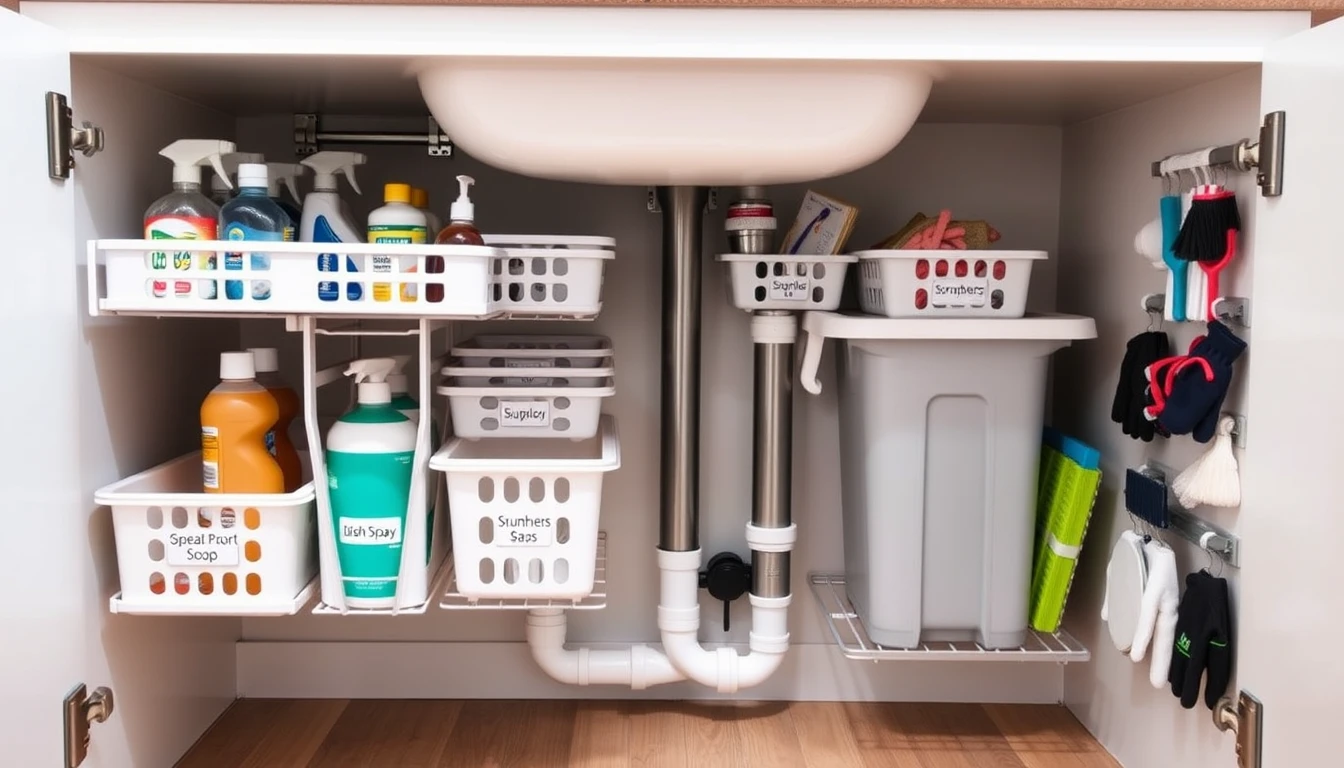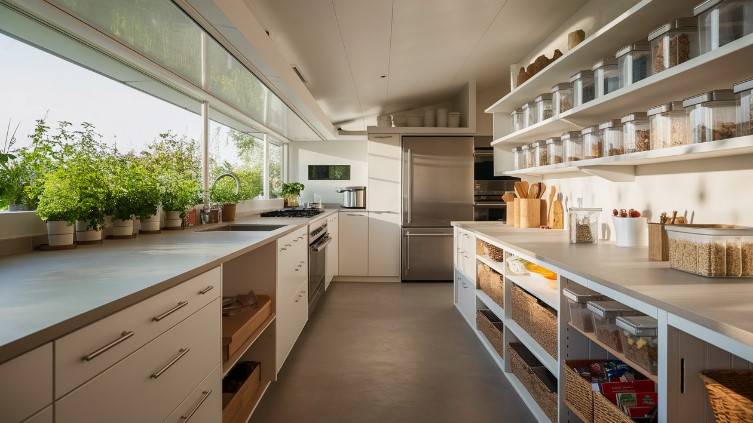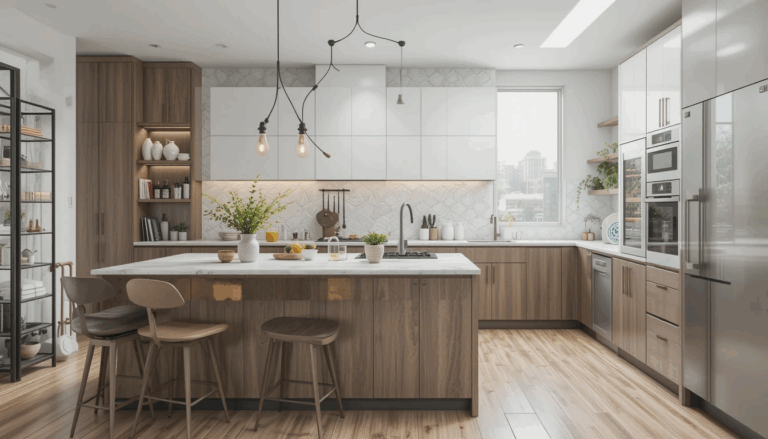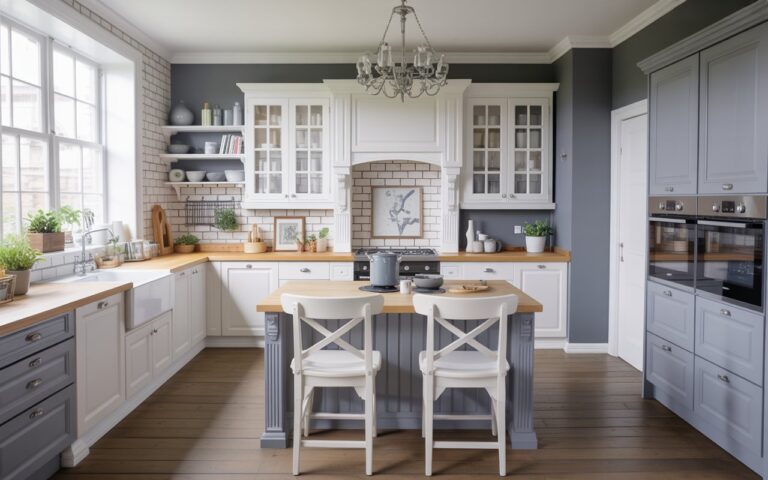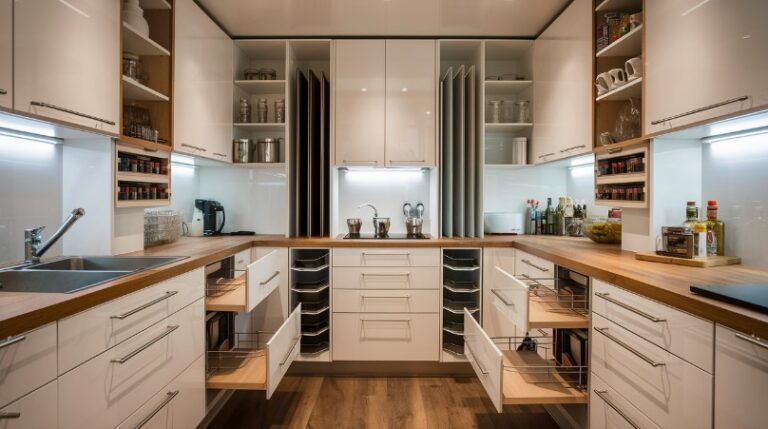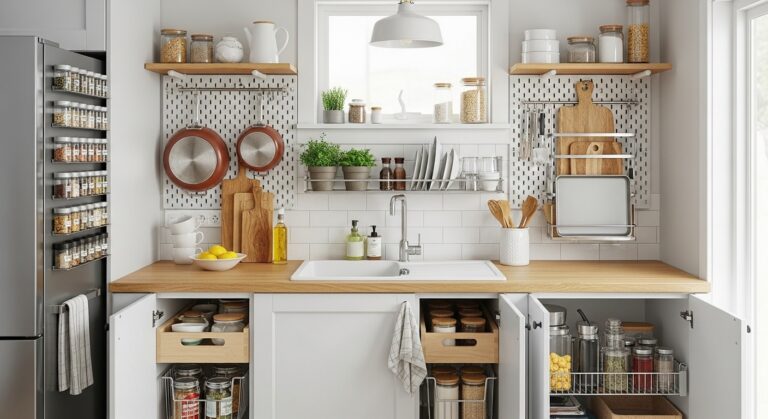9 Small Kitchen Solutions: Under-Sink Storage Ideas
Maximizing under-sink storage in a small kitchen is tough, Every inch counts.
This spot often gets messy with cleaning supplies and trash bags. Finding things becomes difficult.
But, the right solutions can make a big difference, It can turn into a useful storage area.
Options include pull-out drawers, tiered shelves, tension rods, and small organizers. This guide offers nine ideas to save space under the sink.
These solutions will keep your kitchen organized and your essentials easy to find.
Read more : How to Organize a Narrow Kitchen Pantry
1. Stackable Bins

Stackable bins revolutionize under-sink organization in small kitchens.
Available in various sizes, they optimize vertical space and keep items contained.
The main advantage is, easy access and visibility. It eliminates the need to dig through clutter.
When selecting bins, consider size and material.
Clear plastic bins are ideal for quick visibility.
For durability, choose heavy-duty bins with handles. Shallow bins are more efficient in tight spaces.
Make sure the bins are strong, durable to prevent tipping.
With stackable bins, under-sink storage becomes organized and efficient.
2. Tiered Shelving Units
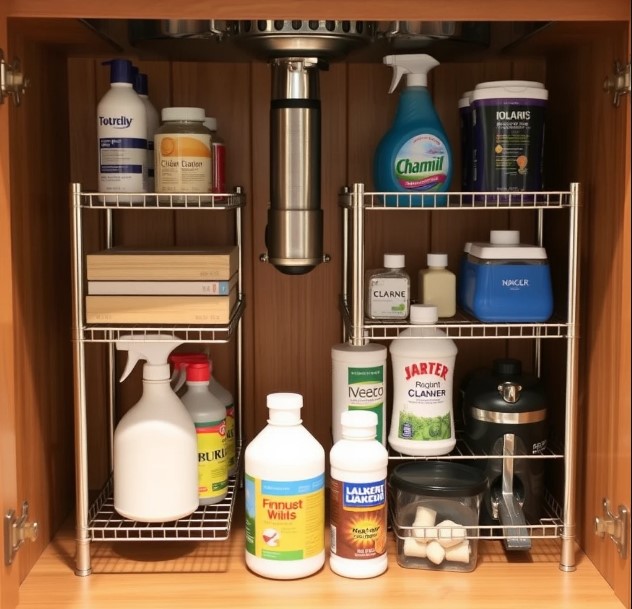
Tiered shelving units are perfect for under-sink storage when space is limited. They use vertical space well.
It makes cleaning supplies, toiletries, and small kitchen items easy to access. This prevents clutter. You can see and grab what you need quickly.
Advantages: These shelves maximize vertical storage, crucial for small kitchens. They keep items organized and prevent clutter.
Recommendations: Choose adjustable shelves to accommodate plumbing. These allow you to set the height between shelves, making them versatile.
This ensures everything stays neat around pipes and drains.
3. Pull-Out Drawers
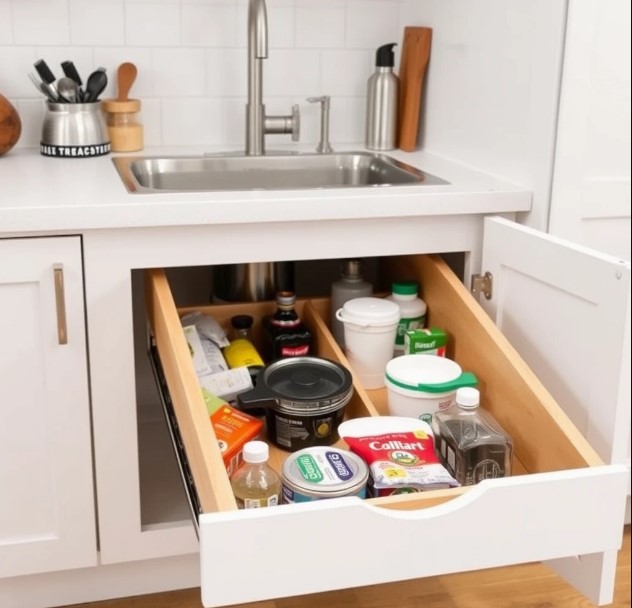
In small kitchens, pull-out drawers boost under-sink storage. They help you reach items that often get lost in deep spaces.
These drawers use wasted space to keep supplies organized. You won’t need to squat or search; everything is within reach.
They hold items in a way that prevents leakages and breakage. You can find pull-out drawer systems at Wayfair, The Home Depot, and IKEA.
For a custom option, consider a DIY project with drawer slides and strong wood.
Pull-out drawers improve your kitchen’s function and organization. You can choose to build or buy them.
4. Lazy Susan
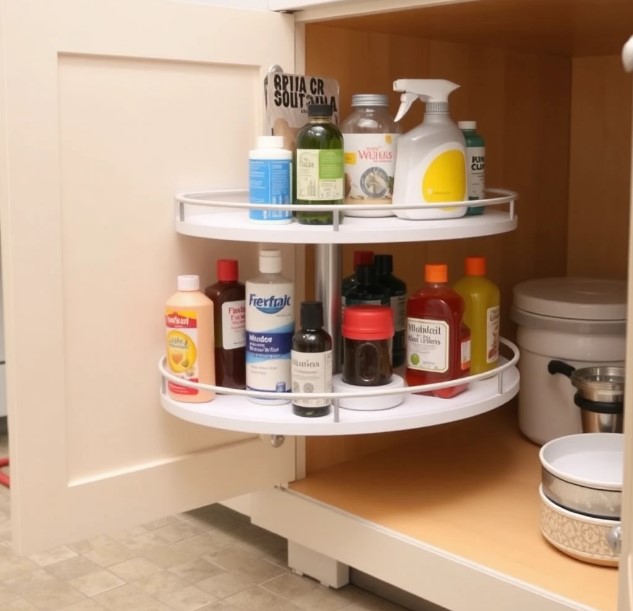
Lazy Susans are a game-changer. They maximize storage under the sink.
You can easily reach items in deep cabinets because they have rotating shelves.
A simple spin brings cleaning supplies, oils, and other essentials to the front.
This feature saves you time and frustration.
The rotating design makes finding items in tight spaces easy.
Lazy Susan can double a shelf’s usefulness by utilizing vertical space better.
They can easily be tailored for other functions. You can choose sizes that fit your cabinet perfectly.
Lazy Susans are ideal for cleaning products, spice jars, and small containers. They keep these items neat and easy to find.
5. Tension Rods
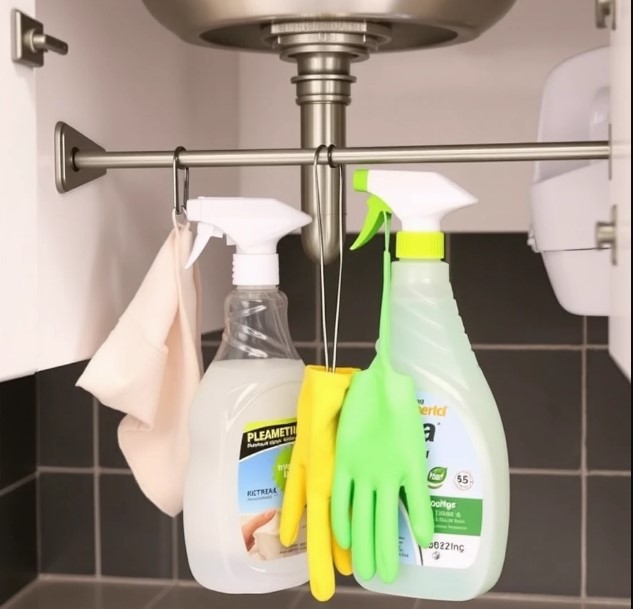
Tension rods are perfect for small kitchen under-sink storage. They’re simple to install and offer easy access to cleaning supplies.
You can hang spray bottles, clothes, and gloves on a rod. This keeps them off the floor and within reach.
Benefits include keeping spray bottles upright to prevent spills. This makes grabbing them easy and eliminates clutter searches.
Additionally, tension rods use vertical space well, freeing cabinet bottoms for other items.
For installation, adjust the rod to fit your cabinet. Set it at a height suitable for your items. Ensure it’s tight enough to hold weight but not overly tight.
Adjust the height based on the size of your cleaning products.
6. Over-the-Door Organizers

For tiny kitchens, over-the-door organizers are ideal. They make use of the area behind the cabinet or pantry doors.
This adds more storage and conserves floor space. These organizers can store many items, keeping everything tidy and accessible.
By converting unused door areas into practical storage, they maximize vertical space. In tiny kitchens where every inch counts, this is crucial.
They hide and show daily essentials. You can store sponges, dish soap, and cleaning supplies in them.
Small pantry items like bags, plastic wrap, and spices also work well with them. There, you can also store kitchenware, paper towels, and bottles.
These organizers are available in different sizes and styles. For a customized solution, they fit various doors.
7. Wire Baskets
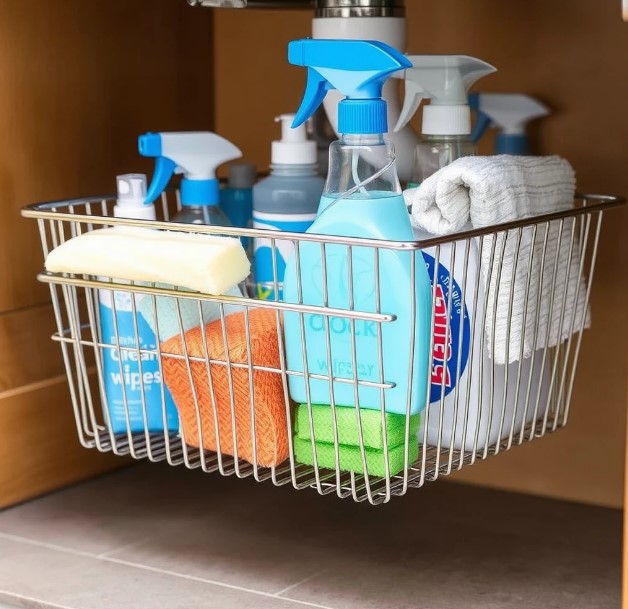
A useful way to arrange the area beneath your kitchen sink is with wire baskets.
They keep similar products together, such as wipes, cleaning sprays, and sponges.
When you need something, this eliminates the need to search around. Air can flow through the breathable mesh.This helps you avoid mold and mildew and stop moisture accumulation.
They are easy to pull out for access because they are strong and lightweight.
To maximize your available space, try utilizing a variety of sizes.
Sponges and cloths are ideal for small baskets. Larger baskets hold bottles and spray cleaners.
Stackable options come in handy in confined spaces. Selecting baskets with movable dividers allows you to set.
8. Caddies
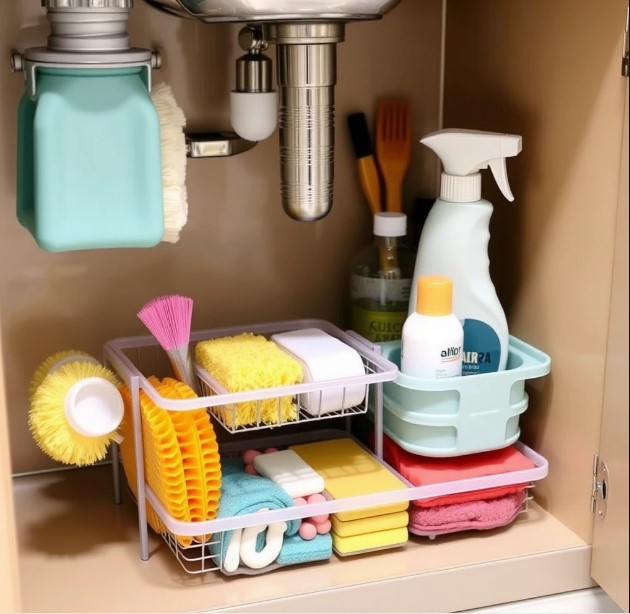
Under-sink spaces in tiny kitchens can achieve an organized appearance with portable caddies.
They contain sponges, scrubbers, dishware, and cleaning supplies. They are portable, so cleaning is faster.
Different caddies work on many tasks. The kitchen is a good place for a shower caddy. It is multi-compartment, water-resistant, and long-lasting.
A multi-tiered caddy with movable sections is a better choice. It’s great for brushes and bottles.
Choose a slim caddy for a modern look that fits well in small spaces. When cleaning or moving things, a caddy with a handle makes transportation easy.
9. Labeling Systems

Without labels, under-sink storage in tiny kitchens can quickly become disorganized.
Bins with labels are easier to find and maintain organization. In confined spaces, this is essential.
Labelling saves time, improves organization and reduces clutter. This works so well for trash bags, sponges, and cleaning supplies. To indicate the proper placement of objects.
A label maker is perfect for a tidy appearance. Adhesive, waterproof labels are also excellent. They are easy to read and long-lasting.
You can arrange things according to categories like “Trash Bags” or “Cleaning Supplies.”
In small kitchens, maintaining organization is essential. Effective labeling improves the efficiency of under-sink storage.
Conclusion
Enhancing under-sink storage capacity in compact kitchen spaces boosts organizational effectiveness and functional productivity.
Maximize this area by incorporating pull-out drawers alongside adjustable shelves and tiered racks.
Stackable bins combined with labeled baskets provide straightforward access while minimizing disarray.
Install tension rods combined with hooks to organize cleaning supplies and small tools.
Custom organizers adapt to your needs and maximize space.
Frequently inspect and eliminate unnecessary objects to maintain a tidy and operational space.
Implementing these inexpensive practical solutions will bring organization back to your disordered kitchen.
The project will become both more visually appealing and functionally effective through their efforts.
An under-sink organizational system is essential for maintaining a neat and efficient kitchen space where stress levels remain low. The validity of this statement extends to diminutive areas.
1. How can I maximize storage space under the sink without cluttering it?
Begin optimizing under-sink storage by eliminating superfluous items.
Deploy stackable shelves to enhance vertical storage capacity. Explore adjustable pipe organizers to maintain a tidy space.
Arrange comparable items into storage containers for simplified retrieval.
Utilize distinctly marked containers to facilitate immediate recognition. Integrate pull-out drawers to facilitate access to items stored at the back.
Attach adhesive hooks to cabinet doors for organizing small items.
Utilize waterproof liners to safeguard surfaces from liquid accidents. These techniques guarantee an orderly and reachable under-sink space despite kitchen size limitations.
2. How do I organize under the sink while keeping it visually appealing?
To organize under the sink and keep it tidy, start by decluttering. Remove any unnecessary or expired items.
Use stackable or tiered organizers to save vertical space. Clear bins or labeled containers help keep items accessible and easy to identify.
Consider a pull-out drawer system. This maintains functionality while reducing visual clutter.
For a cleaner look, choose matching storage in neutral or cohesive colors. Good options are white, gray, or soft pastels.
Install tension rods to hang spray bottles. Attach adhesive hooks inside cabinet doors for tools like brushes and gloves.
Line the cabinet base with a waterproof mat. This prevents damage, keeping the area looking neat.
3. What are the best ways to keep under-sink storage clean and odor-free?
Clear out everything from under the sink. This keeps it clean and odor-free. Remove all items completely.
Cover the cabinet base with waterproof mats or liners to prevent spills and leaks. This makes cleaning easier.
Store cleaning supplies in caddies or airtight containers. This helps avoid moisture.
Regularly check for plumbing drips. Standing water can cause odors. Fix any issues right away to prevent mildew.
Place an open container of activated charcoal under the sink. This absorbs smells and keeps things fresh.
Clean thoroughly every month. Use a disinfectant on all surfaces and keep the cabinet dry.
4. How Do I Organize Cleaning Supplies Under the Sink?
Under the sink, organizing cleaning products calls for clever use of space. It has to keep things clear and easily available.
Start by organizing—clear seldom-used or expired items. Sort objects by category—that is, sprays, cloths, sponges—using stackable bins or baskets.
Install a tension rod to hang spray bottles, keeping them off the surface and freeing up space.
Consider adding pull-out shelves or sliding organizers. They make it easy to access items stored at the back.
Use vertical space. Install tiered racks or hooks on cabinet doors for small tools like brushes and gloves.
To prevent water damage, use waterproof liners.
Store items in leak-proof containers. Keep frequently used supplies in the front and less-used items at the back.
